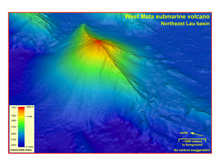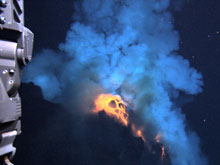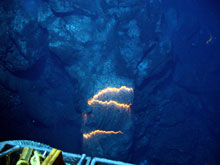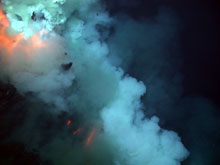
An eruption near the summit of the West Mata volcano. Click image for larger view and image credit.

![]() Click here to view the Northeast Lau Response Cruise 2009 slideshow.
Click here to view the Northeast Lau Response Cruise 2009 slideshow.
Northeast Lau Response Cruise (NELRC)
May 5 – 13, 2009
Joseph Resing
Response Cruise Chief Scientist
Robert Embley
Response Cruise Co-chief Scientist
Northeast Lau Response Team
See Explorers
![]() An underwater volcanic spews superheated lava into the ocean! (Short Clip)
An underwater volcanic spews superheated lava into the ocean! (Short Clip)
![]() The remotely operated vehicle Jason gets close to magma explosions and lava flows on West Mata volcano. (Short Clip)
The remotely operated vehicle Jason gets close to magma explosions and lava flows on West Mata volcano. (Short Clip)
For more information on this expedition, check out the Explorer Blog:
Northeast Lau Basin Blog ![]()
![]() , an account of the response cruise to the Northeast Lau Spreading Center, located in the Southwest Pacific within the triangle formed by Samoa, Tonga, and Fiji.
, an account of the response cruise to the Northeast Lau Spreading Center, located in the Southwest Pacific within the triangle formed by Samoa, Tonga, and Fiji.
The Northeast Lau Response Cruise (NELRC) in May 2009 visited the sites of two recent eruptions in the northeast Lau Basin, which had been discovered in November 2008 during an expedition on the research vessel R/V Thomas G. Thompson. The response expedition expected to find recent eruption deposits at both sites: the northeast Lau Spreading Center (NELSC) and West Mata. We also hoped that at least one site would still be in eruption, which is what we found at West Mata volcano. The cruise members subsequently spent six days characterizing the volcanic deposits and associated phenomena and providing fundamental new insights on eruptive phenomena in this environment — including the first observations of molten lava actively erupting in the deep ocean at West Mata volcano.
Background
During the expedition in November 2008, researchers discovered the first suspected eruption site at the southern segment of Northeast Lau spreading center (NELSC) and a second at West Mata, a small submarine volcano lying between the NELSC and the frontal magmatic arc of the Tonga-Kermadec subduction zone, about 241 kilometers (150 miles) southwest of Samoa. Conductivity-temperature-depth (CTD) surveys in 2008 indicated hydrothermal water column plumes found from 800 to 1,000 meters (2,600 to 3,300 feet) above the suspected location of the eruption at the NELSC contained high concentrations of volcanic glass shards and H2 (hydrogen). The combination of the extreme elevated dissolved H2concentrations and the presence of sharp-edged shards provided unambiguous evidence of the interaction between molten rock and seawater. Near-bottom temperature anomalies greater than 0.5° Centigrade (33º Fahrenheit) over a small region of the neovolcanic ridge indicated the likely location of the eruption.
Also in November 2008, the second eruptive site, West Mata, had an intense plume rising about 175 m (575 ft) with among the highest values of turbidity, H2, 3He (helium), oxidation-reduction potential anomaly, and pH anomaly ever measured in a hydrothermal plume! There was an abundance of large shards in the plume. High acoustic backscatter derived from the research vessel (R/V) Thompson’s EM300 multibeam sonar system was consistent with very young/current volcanic activity. This was a very exciting result, because West Mata would represent only the second site on the planet where we could study an erupting submarine volcano.
Studies of the long term eruption at NW Rota-1 volcano in the Mariana arc have provided dramatic first insights on the physical volcanology, chemistry, and biology of a submarine eruption (Embley et al., 2006; Chadwick et al., 2008: Resing et al., 2008; Walker et al., 2008; Limen et al., 2006). Web sites relating to past investigations at NW Rota-1 include: http://nwrota2009.blogspot.com ![]()
![]() and the Submarine Ring of Fire 2006 Exploration. The West Mata site is much deeper and could represent one of several very young eruptive centers in the area, as well as the first opportunity to sample magmatic fluids from a boninitic (glass-containing rock) magmatic system.
and the Submarine Ring of Fire 2006 Exploration. The West Mata site is much deeper and could represent one of several very young eruptive centers in the area, as well as the first opportunity to sample magmatic fluids from a boninitic (glass-containing rock) magmatic system.
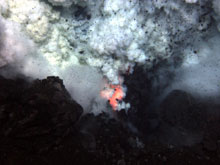
An explosion near the summit of West Mata volcano throws ash and rock into the ocean, as molten lava glows below. Click image for larger view and image credit.
Accomplishments
During the 2009 response cruise, we conducted seven Jason remotely operated vehicle (ROV) dives. The Jason ROV is operated by Woods Hole Oceanographic Institution (WHOI). Within a little more than an hour of reaching the bottom at West Mata on the first dive an active eruption was discovered at 1,205 m (3,950 ft) near the summit of the volcano, at a site we named Hades. The eruption was characterized by glowing molten lava, explosions, the creation of large amounts of volcanic sands, and the active formation of pillow lavas.
An additional four dives at West Mata revealed much about its current and past volcanic activity. We also determined the extent of the eruptive area, stretching about 1,000 m (3,281 m) — the length of a football field — along the north/northwest summit of the volcano. The final dive revealed large magma (molten rock) bubbles, presumably from the expansion of vaporous water and other gases that were exsolved (released) from the magma, and independent magmatic fluids and/or, entrained interstitial seawater.
This was the first ever observation of active lava flows in the deep ocean, which is significant because the vast majority of the earth’s crust was formed at submarine volcanoes in the deep sea, and most of the volcanic eruptions on earth take place under the sea’s surface. Thus, this is the first documentation of one of the most fundamental processes forming the earth’s surface. We conducted five dives at West Mata, and we observed active eruption during every dive.
We collected samples of rocks, sands, microbes, fluids, and microbiology throughout the five dives. In addition to the Jason operations, the Monterey Bay Aquarium Research Institute (MBARI) autonomous underwater vehicle (AUV) D. Allan B. conducted operations and made high resolution maps of the volcano. Two small hydrophones (underwater listening devices) were also deployed by Jason within 20 to 40 m (66 to 131 ft) of the eruption site. We will use these data to compare the short-term magmatic degassing cycles at West Mata to those recently quantified at the Northwest Rota-1 site in the Mariana arc. (Chadwick et al., 2008).
We conducted two dives at the NELSC. The first dive landed on the western side of a recent lava flow, suggesting that we had located, in part, the site of the recent eruptive activity. We named this eruption deposit the Puipui lava flow. However, aside from the fresh lava flows and volcanic debris, we found no evidence of new and/or enhanced hydrothermal activity along the ridge. A CTD tow-yo revealed no major hydrothermal plumes in the area and no near-bottom temperature anomalies over the eruption site. The absence of an extant (obvious) hydrothermal system along this part of the ridge indicates that the lava flow was probably quite small.
We deemed it critical to collect the volcanic and hydrothermal products of the eruption sites as soon as possible. These will help us to understand the evolution of hydrothermal venting and biological succession in the context of observations at other back-arc sites, most notably those at the Ridge 2000 Eastern Lau Integrated Studies Site. Observing the early stages of magmatism and hydrothermal activity, where magmatic fluids are likely in greater supply, is essential to understanding the evolution of these hydrothermal systems. The ability of macro- and micro-fauna to colonize these new sites may rely on the evolutionary state of these volcanic-hydrothermal systems. A system rich in sulfurous acid may be a poor host to some forms of biological activity, while suitable to others. As the system evolves, the biologic assemblage is likely to shift to one closer to that observed at longer-lived systems.

A close-up view of shrimp at the summit of West Mata volcano. Click image for larger view and image credit.
In addition to the Jason and AUV dives, the locations of some of the CTD tows and casts over the eruption sites were reoccupied to provide a time-series of the water-column anomalies. Finally, a hydrophone mooring deployed in December 2008 (as a response to the discoveries of the eruptions) was recovered on the latter part of the cruise.
Funding and Participation
This NERLC project was funded jointly by NOAA and the National Science Foundation (NSF). NOAA Ocean Explorer and NOAA Pacific Marine Environmental Laboratory (PMEL) each funded three days of ship time. NSF funded the remaining six ship days and 12 days of Jason usage. In addition, NOAA-OE funded the exploration budget for NOAA-PMEL and its Joint Institute Partners, Oregon State University and the University of Washington.
NSF through the Ridge 2000, MARGINS, and core programs funded the scientific and support costs for the University of Washington (UW), the University of Hawaii, the Monterey Bay Aquarium Research Institute (MBARI), Western Washington University, the Marine Biological Laboratory, and the Woods Hole Oceanographic Institution.
Indirect funding (through UW for travel and analysis) also went, or will go, to Portland State University, Moss Landing Marine Labs, the University of Tulsa, Harvard University, and Pennsylvania State University. Samples were also collected for the University of California, Santa Cruz. Finally, MBARI (four participants) and PMEL (four federal scientists) provided funding for their scientists' salaries in addition to at-sea participation.
References Cited
Chadwick, W. W., Jr., Cashman, K. V., Embley, R.W., Matsumoto, H., Dziak, R.P., de Ronde, C. E. J., Lau, T.K. A., Deardorff, N., and Merle, S. G., 2008b, Direct Video and Hydrophone Observations of Submarine Explosive Eruptions at NW Rota-1 Volcano, Mariana Arc: J. Geophys. Res., v. 113, p. B08S10, doi:10.1029/2007JB005215.
Embley, R. W., Chadwick, J., W. W. , Baker, E. T., Butterfield, D. A., Resing, J. A., de Ronde, C. E. J., Tunnicliffe, V., Lupton, J. E., Juniper, S. K., Rubin, K. H., Stern, R. J., Lebon, G. T., Nakamura, K., Merle, S. G., Hein, J. R., Wiens, D. A., and Tamura, Y., 2006, Long-Term Eruptive Activity at a Submarine Arc Volcano: Nature, v. 441, p. 494-497.
Limen, H., Juniper, K., Tunnicliffe, V., and Clement, M., 2006, Benthic community structure on two peaks of an erupting seamount: Northwest Rota-1 Volcano, Mariana Arc, western Pacific: Cah. Biol. Mar., v. 47, p. 457-463.
Resing, J. A., et al. (2007), Venting of acid-sulfate fluids in a high-sulfidation setting at NW Rota-1 submarine volcano on the Mariana Arc, Econ. Geol., 102, 1047–1061.
Walker, S. L., Baker, E. T., Resing, J. A., Chadwick, W. W., Jr. , Lebon, G. T., Lupton, J. E., and Merle, S. G., 2008, Eruption-fed particle plumes at a submarine volcano: NW-Rota-1, Mariana Arc: J. Geophys. Res., v. 113, p. B08S11, doi:10.1029/2007JB005441.
Sign up for the Ocean Explorer E-mail Update List.








